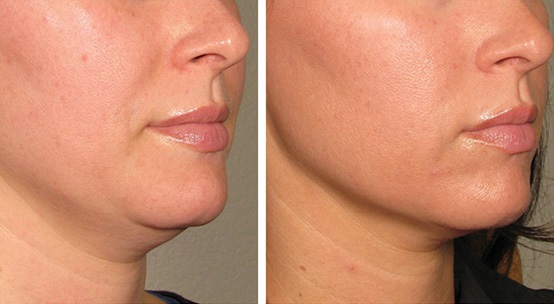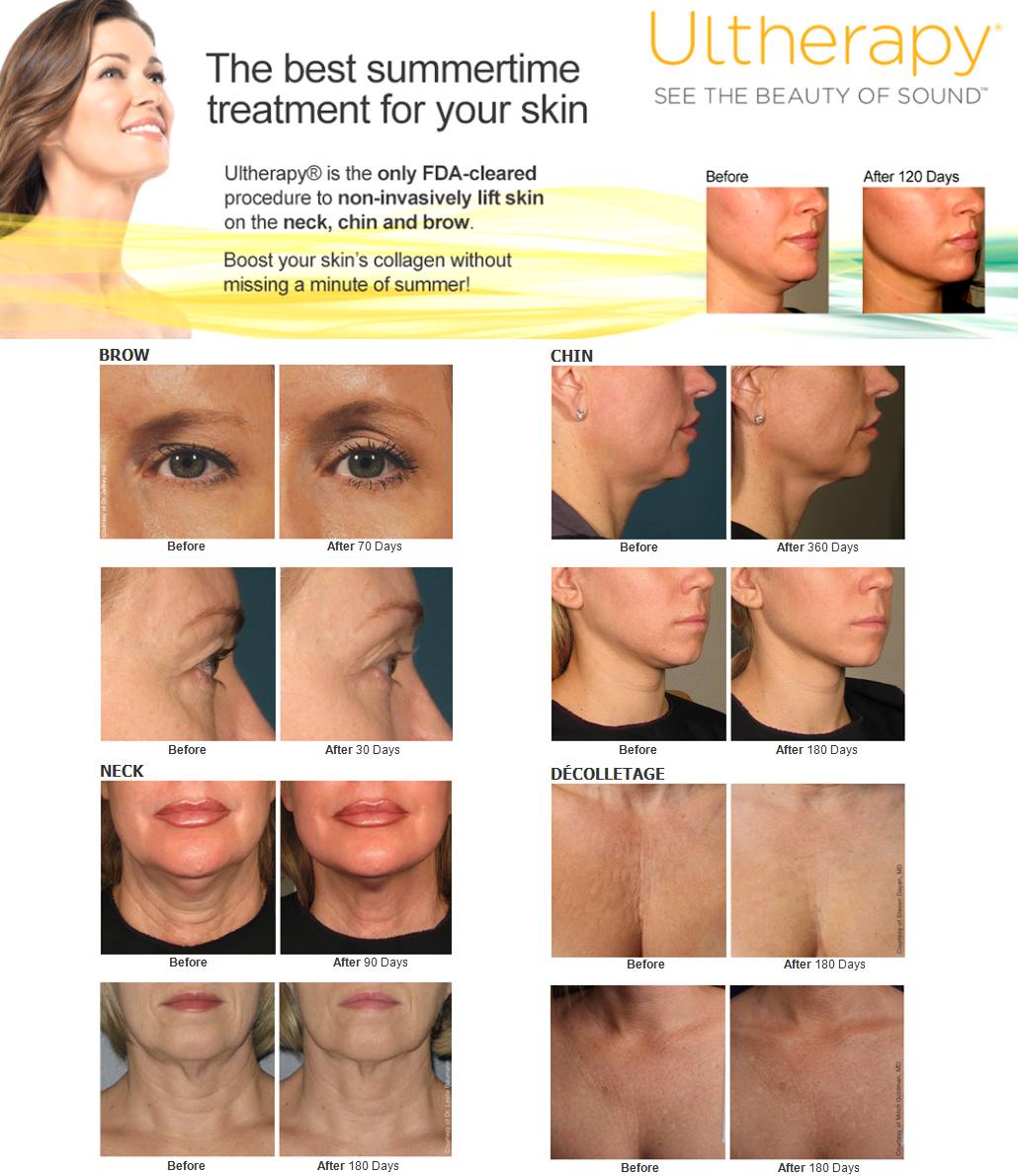The Additions of Ultherapy: What You Required to Learn About This Non Surgical Lift Solution
Ultherapy attracts attention as a prominent non-surgical lift alternative, leveraging ultrasound technology to enhance skin firmness. This procedure not just targets different areas however additionally accommodates a wide age array. People commonly seek it for its marginal downtime and prompt advantages. Recognizing the complexities of Ultherapy-- from treatment locations to candidateship-- is vital for anybody considering this renewal method. What are the essential elements to review before proceeding?
What Is Ultherapy and Just How Does It Function?
Ultherapy is a non-invasive cosmetic procedure that utilizes ultrasound technology to promote collagen production in the skin. Approved by the FDA, it targets the deeper layers of the skin, specifically the foundational layer commonly attended to in plastic surgery. During the treatment, a handheld tool provides concentrated ultrasound energy to promote the skin, triggering a natural recovery response. This process motivates the production of brand-new collagen, which helps to tighten and raise the skin over time.
The procedure is usually well-tolerated, requiring no cuts or downtime, making it an appealing alternative for those seeking facial restoration without surgery. The treatment can be customized to match private demands, enabling experts to deal with details locations of issue. Outcomes gradually show up over a couple of months as collagen builds, providing a refined yet recognizable improvement in skin texture and firmness. Generally, Ultherapy stands for a modern-day approach to skin tightening up and restoration.
Trick Benefits of Deciding On Ultherapy
Numerous individuals seeking non-surgical skin renewal discover Ultherapy to be an appealing choice due to its range of advantages. One of the primary advantages of Ultherapy is its capability to promote collagen manufacturing, leading to tighter and firmer skin in time. This treatment utilizes ultrasound modern technology, which permits precise targeting of deeper skin layers without damaging the surface.
Additionally, Ultherapy is a non-invasive procedure, suggesting there is no requirement for medical cuts or extensive recuperation durations. Individuals can typically resume their day-to-day activities immediately after therapy. The outcomes of Ultherapy can be steady, supplying a natural-looking lift that boosts the individual's look without a quantum leap.
Moreover, Ultherapy appropriates for numerous skin kinds and can be personalized to fulfill private requirements. With its tested effectiveness and security, lots of people think about Ultherapy a compelling choice for achieving youthful skin without the demand for surgical treatment.
The Ultherapy Treatment Process
The Ultherapy therapy process involves a series of well-defined actions created to ensure excellent outcomes. An assessment allows the professional to analyze the individual's demands and establish the suitable therapy plan. During the treatment, the skin is cleansed, and an ultrasound gel is related to assist in smooth application of the device.
The Ultherapy tool utilizes focused ultrasound power to stimulate collagen manufacturing deep within the skin. As the ultrasound power is delivered, the person may experience a feeling of heat or small pain, which is usually well-tolerated. The period of the treatment varies relying on the location being addressed but typically lasts in between 30 to 90 mins.
Post-treatment, clients can resume their everyday tasks with minimal downtime. Outcomes begin to progressively appear over the complying with weeks, as the body normally creates new collagen, improving skin suppleness and flexibility.
Locations of the Body That Can Be Treated

Numerous areas of the body can benefit from Ultherapy therapy, making it a versatile alternative for those seeking non-invasive skin tightening up. Mostly, the face is a centerpiece, with Ultherapy effectively raising and tightening up the skin around the brow, cheeks, and jawline. This therapy can likewise address drooping skin on the neck, offering an invigorated appearance.
Along with facial locations, Ultherapy is suitable for the décolletage, where it helps enhance skin texture and firmness. The therapy can encompass other locations, such as the arms and abdominal areas, where loose skin might occur.
Expected Outcomes and Healing Time
Expected outcomes from Ultherapy commonly consist of a recognizable training and tightening of the skin, with outcomes coming to be much more noticeable over time as collagen manufacturing boosts. Lots of clients report noticeable renovations within 2 to 3 months post-treatment, with optimal results commonly seen around 6 months. The non-invasive nature of Ultherapy contributes to its charm, as it commonly calls for minimal downtime.
Clients might experience light swelling, soreness, or tenderness in the treated locations, yet these negative effects normally settle quickly. Many individuals can resume their regular activities promptly after the treatment.
While the long life of results varies, impacts can last as much as a year or longer, relying on specific skin problems and maturing procedures. Normal follow-up sessions might aid keep the desired outcomes, enhancing the overall effectiveness of the treatment.
Who Is a Good Candidate for Ultherapy?
Determining who is a good prospect for Ultherapy involves taking into consideration numerous variables. The excellent age variety normally falls between 30 and 65, while skin kind and any type of underlying health conditions likewise play necessary functions in eligibility. Understanding these criteria can help people examine whether Ultherapy is an appropriate option for them.

Perfect Age Range
Ultherapy is most effective for individuals in their 30s to 60s that are starting to see indicators of aging, such as drooping skin or loss of elasticity. This age range normally stands for a transition phase where the skin's natural collagen manufacturing begins to decrease, making it an ideal time to evaluate non-surgical lifting alternatives. Candidates in their 30s may seek Ultherapy as a preventative procedure, while those in their 40s to 60s usually look to address more pronounced indications of aging. Significantly, Ultherapy is not limited to a particular market; both guys and ladies can benefit. Ultimately, the most effective candidates are those who desire subtle lifting and tightening up without the demand for intrusive treatments.
Skin Type Considerations
People thinking about Ultherapy must take their skin type into account, as it plays a significant role in therapy performance. Normally, those with skin that shows indicators of aging, such as drooping or laxity, are prime prospects. Ultherapy is particularly advantageous for individuals with reasonable to tool skin tones, as the ultrasound power targets much deeper layers without damaging the surface. Conversely, people with darker skin types may encounter a greater threat of pigmentation modifications. Furthermore, skin texture and flexibility are crucial elements; those with more resistant skin may see much better results. Inevitably, an appointment with a qualified service provider can help establish suitability based upon particular skin characteristics, making certain a customized approach for ideal outcomes.
Wellness Conditions Affecting Qualification
Eligibility for Ultherapy can be influenced by different health problems that may impact the skin and overall wellness. Prospects with specific skin problems, such as energetic acne, dermatitis, or psoriasis, may not appropriate, as these conditions can conflict with the treatment's efficiency and safety and security. Furthermore, people with a history of current facial surgical treatments or those that have gotten injectable fillers in the targeted locations may require to wait before undertaking Ultherapy. Patients with specific clinical conditions, like autoimmune illness or extreme persistent diseases, need to also speak with their medical care company to establish their suitability. Ultimately, a detailed pre-treatment assessment is vital to assure the most effective results and to determine any kind of potential risks connected with the treatment.
Price and Factors To Consider for Ultherapy Therapy
Understanding the expense of Ultherapy treatment is vital for prospective prospects. Rates can vary based on elements such as area and the degree of therapy required. Additionally, funding options may be offered to assist handle the cost.
Treatment Pricing Overview
Expense is a considerable variable when thinking about Ultherapy therapy, as rates can differ extensively relying on numerous components. Variables affecting the price consist of the therapy area, the service provider's experience, and geographic location. Usually, sessions can vary from $1,000 to $4,500, with larger areas or more substantial therapies commanding higher costs. In addition, the variety of sessions needed for excellent outcomes can influence total expenditures (RJ Clinic Ultherapy). It is necessary for potential patients to talk to licensed professionals to receive personalized browse around this web-site quotes based upon their unique needs. Openness in pricing is important, as covert charges or add-ons may affect the total price. Comprehending these variables can aid individuals make educated choices regarding their Ultherapy treatment Get More Information alternatives
Funding Options Available
While taking into consideration Ultherapy therapy, lots of potential clients explore funding choices to manage their expenses properly. Different clinics use settlement strategies that enable patients to spread the expense over several months, making the treatment extra obtainable. Some facilities partner with third-party financing firms, providing choices such as low-interest loans or perhaps interest-free durations. Furthermore, adaptable spending accounts (FSAs) or wellness cost savings accounts (HSAs) may be utilized to cover expenses, depending on private conditions. Clients are urged to ask about possible discount rates for upfront repayments or advertising offers that might be available. Comprehending these funding alternatives can help prospective clients make notified choices concerning their Ultherapy treatment while relieving the monetary problem connected with this procedure.
Frequently Asked Questions
For how long Do the Outcomes of Ultherapy Usually Last?
The period of Ultherapy outcomes differs, commonly lasting in between 6 months to 2 years (RJ Clinic Ultherapy). Variables affecting long life include private skin kind, maturing procedure, and maintenance treatments, which can enhance and prolong the impacts of the treatment

Can Ultherapy Be Integrated With Other Therapies?
Ultherapy can certainly be combined with various other therapies, such as fillers and neurotoxins. This combination method typically enhances general outcomes, giving a more complete renewal effect while dealing with different skin worries at the same time.
Is Ultherapy Safe for All Skin Kinds?
Ultherapy is typically considered safe for various skin types, however private outcomes may vary. Consulting a more certified specialist is important to establish suitability, as skin problem and level of sensitivity can affect therapy end results and safety.
What Are the Prospective Adverse Effects of Ultherapy?
The potential adverse effects of Ultherapy may include temporary soreness, swelling, tenderness, or pain in treated locations. Some individuals might also experience small discoloration or a tingling experience, although these effects usually deal with promptly.

The Number Of Ultherapy Sessions Are Typically Required for Optimal Outcomes?
Commonly, individuals require one to three Ultherapy sessions for excellent results. The exact number may differ based upon skin condition and preferred outcomes, with several experiencing obvious renovations after a solitary treatment. Regular assessments may assist additional sessions.